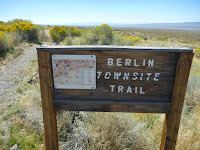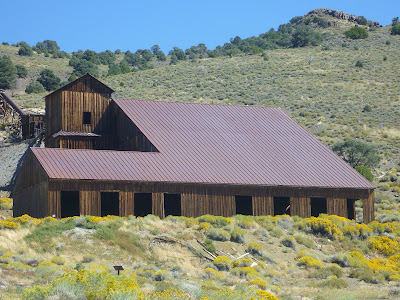 |
| Flooded Forbes Creek at Sugar Pine Reservoir |
The Sugar Pine Dam, constructed between 1979 and 1982, is an earthfill embankment dam, located about seven miles northeast of Foresthill in Placer County, California [1]. The Sugar Pine Reservoir—let's just call it a lake from here on—supplies municipal water for the Foresthill community. It is a serene recreational site with swimming, fishing, watercrafting, hiking, bicycling, horseback riding and camping options.
A four-mile-long hiking and bicycling trail “circles” the lake. Its perimeter is not circle-shaped: the loop trail winds around the lake by taking you out-and back around lake arms—flooded sections of former creeks. Forbes Creek and Shirttail Creek are tributaries to the lake. Past the dam, overflow water follows Shirttail Creek downstream into the North Fork American River.
In June of this year I hiked around the lake—an easy walk. I started out counterclockwise from the boat ramp. About half-way around, I found various interpretive Tahoe National Forest panels next to the lake shore informing about the local history, geology and wildlife. In the following, I am sharing some of the pictures I took on my round trip by framing them with quotes and notes based on interesting panel text.
The first panel I encountered had the title Under the Water. It takes us back to the days before the reservoir was built, inspiring us to ponder what being at this place may have been
like at different times in the past:
When Shirttail Canyon and Forbes Creek
were dammed to form Sugar Pine Reservoir, many Native American and
historic sites were flooded. Local Native Americans used the area for
hunting and gathering. Acorns were gathered and various seeds were
processed by grinding bedrock milling stations.
Historic use included mining and
grazing. Shirttail Canyon was named by early miners. Two miners,
Tuttle and Van Zandt, discovered a lone miner in the canyon wearing
only a short shirt. They asked the miner, “what in the devil's name
do you call this place” The lone miner laughingly answered, “Don't
know any name for it yet, but we might as well call it Shirt-tail as
anything else.”
Old fence lines associated with grazing
can still be seen. Historic maps indicate that a road and an
unidentified building were flooded.
 |
| View from the Under the Water panel: reservoir water now covering Native American and historic mining and grazing sites |
Continuing on, you will see panels that describe how ospreys live and fish, and how fallen trees sustain the forest around the lake and beyond. Then, there comes the panel with the title Contribution to the Great War:
Chromite, a mineral found in the Sugar
Pine area, was a critical resource during World War I. Ferrochrome,
which is made from chromite and steel, was used as armor plating for
tanks and equipment.
Chromite mining in this area began in
1876, but was most active, and most important, from 1917 to 1919 to
support the war effort.
 |
| Shirttail creek bridge |
Near the Shirttail creek bridge you may notice an area of thinned forest, where a panel explains that in 2010 small trees and shrubs were removed to leave the remaining forest healthier
and better able to survive drought and wildfire. In 1936, the
McKenzie Mill fire swept through the area and burnt most of the trees.
Walk across the bridge, enter the cedar grove and find the cedar tree with burn marks (fire scars). This tree survived the fire thanks to its thick insulating bark. Fire intensity is key to the outcome of a forest fire:
When wildfires burn too hot and out of
control, they can devastate a forest. However, fire plays an
important role in the forest ecosystem. Low-intensity fire helps
“clean house” by burning up dead material and making more
nutrients and water available for trees and plants to grow stronger
and healthier. Some trees and plants actually need fire to release
their seeds.
A nearby panel about the local Nisenan People says that “in the fall, the Nisenan would often
set the ground litter and vegetation on fire. Since these fires were
low intensity, large trees were unharmed. The burning improved the
growth of grasses which supported and attracted the animals they
hunted..”
 |
| Sprays of cedar branchlets at Shirttail Creek near the Manzanita Day Use Area |
After scanning the old cedar canopy and enjoying the fresh green of many young cedar trees, I left the cedar grove and came to the forest edge, an almost treeless area of pale green serpentine rock. Serpentine minerals are hydrous magnesium iron phyllosilicates. Serpentine is the California State Rock. Geology Created this Forest Edge is the panel title here, reading:
Serpentine rock creates soil that is
toxic to most plants. This is especially noticeable at a forest edge
like this one.
On serpentine soil, trees are sparse
and there are large areas of bare rock. Where the composition of the
soil changes to andesitic (volcanic) based soil, plants and trees are
more abundant.
The change from bare ground to tree
cover is often so abrupt that foresters and soil scientists can map
general soil types using aerial photos [like the one shown on the panel].
 |
| A serpentine rock at the forest edge |
Evergreen manzanita shrubs are not only drought-resistant, obviously they tolerate serpentine soil. You will find them here: the area is even called Manzanita Day Use Area.
 |
| Northeast corner with the Manzanita Day Use Area where fresh Shirttail Creek water is filling the reservoir |
Okay, the last panel (it could be your first if you are on a clockwise round trip) summarizes The Sugar Pine Story:
In 1982 Sugar Pine Reservoir was built
to provide the town of Foresthill with a dependable water source. The
reservoir is not only valuable to residents of Foresthill, but also
to wildlife, fish, and recreationists.
The reservoir is named for the sugar
pine tree, easily recognized by its gigantic cone. The sugar pine is
not as common here today as it once was due to a combination of
historic logging, a 1936 wildfire, and the spread of a disease that
kills sugar pines called White Pine Blister Rust.
Continuing the round trip on the paved trail across the Giant Gap Campground, you will arrive at the point, where a sign indicated you have one mile to travel to the dam. That section is a panel-free, red-dirt single track. Expect some fallen rocks on the path.
 |
| Unpaved trail section between dam and Giant Gap Campground |
The dam area is the western most tip of the reservoir. A short unpaved trail towards the boat ramp concludes the loop.
Note on name of the reservoir loop trail
The trail is frequently referred to as Joshua M. Hard Memorial Trail to honor Army Sgt. Joshua M. Hardt of Applegate, California. Joshua died at age 24 on October 3, 2009, while serving during “Operation Enduring Freedom” [2,3].
Getting to the boat ramp
Sugar Pine Reservoir is located northeast of the city of Auburn in the Sierra Nevada. From the historic mining town of Foresthill, continue northeast on Foresthill Road for about 10 miles. Turn left at the sign for the reservoir and drive downhill for 4 miles to get to the boat ramp parking and picnic areas.
Address: Sugar Pine Reservoir, California 95631.
 |
| Boat ramp area of Sugar Pine Reservoir with dam in the back |
On my visit in mid-June the reservoir was relatively quiet. But I was told larger crowds should be expected on hot summer weekends.
References and more
[1] Sugar Pine Dam. Wikipedia. URL: https://en.wikipedia.org/wiki/Sugar_Pine_Dam.
[2] Army Sgt. Joshua M. Hardt URL: https://thefallen.militarytimes.com/army-sgt-joshua-m-hardt/4316304.
[3] Joshua M. Hardt Memorial Trail at Sugar Pine. Singletracks. URL: https://www.singletracks.com/bike-trails/joshua-m-hardt-memorial-trail-at-sugar-pine/.
[4] Sugar Pine Reservoir. Recreation.gov. URL: https://www.recreation.gov/camping/gateways/2284.



































































